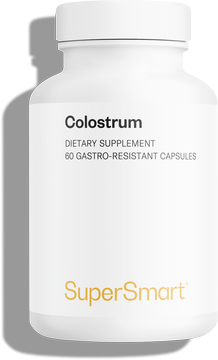Which foods have the highest content of spermidine?
Spermidine is a key substance in our cells, concentrations of which decline with age. Discover the 10 best foods for ensuring a good intake. Which food do you think tops the list?

What is spermidine?
Spermidine is part of the polyamine family. Involved in several vital functions in the body, this organic, endogenous compound was first identified in 1678 in, as its name suggests, human sperm. It is, however, found in all human cells (and in those of mammals in general). Spermidine is primarily a precursor of spermine, which ensures the stability and integrity of body fluids (1).
This famous fountain of youth unfortunately dries up with age but ensuring a regular, adequate intake from the diet can help to compensate for this decline (2-4).
The top 10 spermidine-rich foods to include on your menu regularly
10- Hazelnuts
Few oleaginous fruits contain substantial levels of spermidine, the one exception being hazelnuts, with a respectable 2.1 mg/100 g. A food to add welcome crunch and flavor to salads or satisfy an afternoon craving!
9- Cruciferous vegetables
Do you prefer cauliflower or broccoli? If you’re not a fan of either of these brassicas, bear in mind that their florets (or leaves) contain an average 2.5mg of spermidine per 100g (5).
Eat them raw or steamed to get maximum benefit from their vitamins, minerals and sulfur compounds.
8- Mangos
Clocking up 3mg of spermidine per 100g, mangos are also notable for their vitamin A content (in the form of beta-carotene, responsible for their orange color) as well as polyphenols (including gallic acid, mainly in ripe fruit).
Combine them with bananas (0.86mg/100 g) to end your meal on an exotic note and at the same time boost your spermidine intake.
7- Beef
With 3.7mg spermidine per 100g, beef comes in at a creditable 7th place on our list. So does that mean eating a steak for lunch every day? Absolutely not. According to the French Agency for Food, Environmental and Occupational Health & Safety (ANSES), we should not exceed 500g of red meat a week.
And let’s also remember that grilled meat, particularly barbecued, generates toxic compounds (polycyclic aromatic hydrocarbons and heterocyclic amino acids) which accelerate cellular aging.
6- Chicken liver
Raising your spermidine levels sometimes requires a little effort! Though perhaps not the most appetising, chicken liver is even better than steak, with a very decent 4.8 mg/100g (6) – not to mention its excellent vitamin A, B9, and iron content.
5- Peas
Halfway between a green vegetable and a pulse, peas are often combined with carrots in canned products. But did you know they are packed with spermidine (6.5mg/100 g)? (7).
Very useful for vegetarians or those who do not get on with offal!
4- Mushrooms
Vitamins B3 and D, selenium, potassium, phosphorus: nutrition-wise, mushrooms are already high performers. But to add to their ranking, they are one of the most spermidine-rich plant foods with an impressive 8.8mg/100 g (8).
3- Cheddar (and mature cheeses)
Like many mature cheeses (gouda, brie, parmesan, gorgonzola…), cheddar is chock-full of spermidine with a content nudging 20mg/100g.
But as with beef, that doesn’t mean you should eat huge amounts: restrict yourself to 30g-40g a day so that your salt and saturated fat intake remains moderate.
2- Soya beans
A staple of veggie cooking, soya beans - in the form of tofu, tempeh, miso or vegan milks - are one of the most popular and versatile sources of plant protein.
With a more than respectable 20.7mg/100g, they are second on the podium of the top 10 spermidine-rich foods (9).
1- Wheatgerm
And the spermidine gold medal goes to … wheatgerm! The part that both helps the wheat plant reproduce, and gets eliminated when grain is processed into flour (because the fatty acids it contains accelerate rancidity), wheatgerm reigns supreme with 24.3mg of spermidine per 100g. (10)
It’s usually sprinkled on vegetables, yogurt or cereal.
How to increase your spermidine intake easily
Besides choosing from these various foods every day, it can make sense to opt for a spermidine supplement as an easy and effective way of optimising your intake of this valuable nutrient (with its 100% vegan, gluten- and additive-free formulation, derived from rice extract, the supplement Spermidine provides 3mg of spermidine a day, the highest amount on the market) (11).
References
- Pegg AE. The function of spermine. IUBMB Life. 2014 Jan;66(1):8-18. doi: 10.1002/iub.1237. Epub 2014 Jan 6. PMID: 24395705.
- Soda K, Uemura T, Sanayama H, Igarashi K, Fukui T. Polyamine-Rich Diet Elevates Blood Spermine Levels and Inhibits Pro-Inflammatory Status: An Interventional Study. Med Sci (Basel). 2021 Mar 29;9(2):22. doi: 10.3390/medsci9020022. PMID: 33805535; PMCID: PMC8103277.
- Madeo F, Carmona-Gutierrez D, Kepp O, Kroemer G. Spermidine delays aging in humans. Aging (Albany NY). 2018;10(8):2209-2211. doi:10.18632/aging.101517
- Nishimura K, Shiina R, Kashiwagi K, Igarashi K. Decrease in polyamines with aging and their ingestion from food and drink. J Biochem. 2006 Jan;139(1):81-90. doi: 10.1093/jb/mvj003. PMID: 16428322.
- Sindhu RK, Cohen SS. Propylamine transferases in chinese cabbage leaves. Plant Physiol. 1984 Mar;74(3):645-9. doi: 10.1104/pp.74.3.645. PMID: 16663475; PMCID: PMC1066740.
- Krausová P, Kalač P, Křížek M, Pelikánová T. Content of biologically active polyamines in livers of cattle, pigs and chickens after animal slaughter. Meat Sci. 2006 Aug;73(4):640-4. doi: 10.1016/j.meatsci.2006.03.005. Epub 2006 Mar 18. PMID: 22062564.
- Zoumas-Morse C, Rock CL, Quintana EL, Neuhouser ML, Gerner EW, Meyskens FL Jr. Development of a polyamine database for assessing dietary intake. J Am Diet Assoc. 2007 Jun;107(6):1024-7. doi: 10.1016/j.jada.2007.03.012. PMID: 17524725; PMCID: PMC2848593.
- Muñoz-Esparza NC, Latorre-Moratalla ML, Comas-Basté O, Toro-Funes N, Veciana-Nogués MT, Vidal-Carou MC. Polyamines in Food. Front Nutr. 2019;6:108. Published 2019 Jul 11. doi:10.3389/fnut.2019.00108
- Wang LC. Polyamines in soybeans. Plant Physiol. 1972 Jul;50(1):152-6. doi: 10.1104/pp.50.1.152. PMID: 16658112; PMCID: PMC367332.
- Hirano R, Shirasawa H, Kurihara S. Health-Promoting Effects of Dietary Polyamines. Med Sci (Basel). 2021;9(1):8. Published 2021 Feb 5. doi:10.3390/medsci9010008
- Schwarz C, Stekovic S, Wirth M, et al. Safety and tolerability of spermidine supplementation in mice and older adults with subjective cognitive decline. Aging (Albany NY). 2018;10(1):19-33. doi:10.18632/aging.101354
Keywords
2 Days
Great customer service - responsive …
I ordered from them and my item was unavailable for sometime. I was super happy when they reactivated my order and shipped my item which arrived very quickly. Great customer service.
Ruth Rueter
3 Days
Super fast shipping
Super fast shipping
Donald Borling
6 Days
Reputable companysearch and the number of…
The research and the number of selection of products.
NAKHJAVAN Shervin
19 Days
The Anti Aromatase is a great product
The Anti Aromatase is a great product. You just need to have constant inventory. Recently this product has been out of stock.
GEORGE Verne
21 Days
Great help on chat
Great help on chat. Knowledgeable and friendly.
Jason Argos
24 Days
Customer service was fast and friendly.
Customer service helped to stop the transaction process of the subscription. I appreciated that.
Greenie
25 Days
I order here due to the high quality of…
I order here due to the high quality of the products and the quick delivery of items - thank you
Barbara J
26 Days
SuperSmart's Eye Pressure supplements: highly recommended!
I purchase SuperSmart's Eye Pressure supplements regularly for over 5 years, and gotta say they are truly a wonderful product for my Glaucoma. Highly recommended if you have eye pain from your Glaucoma.
D. Martinez
31 Days
Quick service
Quick service
MONELL
31 Days
Speedy service.
Speedy service.
ROSENTHAL Marvin
35 Days
Clear website- Efficient
Clear website. Excellent search engine and fast delivery!
Mohamad Hussein
37 Days
They have great products.
They have great products.
Vickie
38 Days
Great Shipping Time!
You Have A Great Shipping Time! Praise The Lord!
DMHoge
39 Days
Doctor Recommended!
Good pricing, very good availability, doctor recommended (couldn't find what I needed anywhere else), and it took only a week to arrive (which I can't complain about).
Al
40 Days
Great product and fast shipping
Great product and fast shipping
Marie





